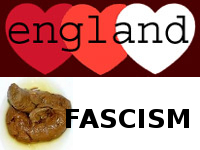For various reasons (largely work related 😦 ) this blog has been pretty quiet recently. But after re-reading Paul Kingsnorth’s ‘What England Means to Me’ post I have been reminded of the reasons why I created this blog in the first place. I cannot be the only person to LOVE ENGLAND, HATE FASCISM, so from now on I shall endeavour to try harder – i.e. post more blogs and actively fight for the English Libertarian cause. In the meantime here’s Paul’s excellent post…
What England Means to Me
Paul Kingsnorth
A few years back, I found myself in a narrow valley on the border between England and Wales. There are some landscapes – fewer as time passes – in which it seems that time has, if not exactly stood still, then been hijacked by some outside force for its own ends. There are some landscapes in which you can sense the ancient heart of the place in the air. This was one of them.
It was a landscape of scattered hill farms, high moors, hedge-lined holloways and winding brooks. Save for the odd industrial shed tacked on to a farmyard, or barbed wire fence, there was little of contemporary England about it. There were few cars. And everywhere, there were textures.
The textures of this valley became more and more noticeable as I walked its length. I took out my camera and began to photograph them at close quarters. Robbed of their wider context they look, when printed, like abstractions. The jigsaw bark of an old tree; white air bubbles on the surface of a blue pond; another tree’s bark, glossy this time and mottled; green moss on a purple gravestone; tree roots snaking through the dust; the parallel lines of a corrugated iron roof.
A legion of textures, colours, surfaces, pictures, crowding in on one another; the patchy, unplanned, diversity of place. This is what England means to me. Place, above all, is what makes my England. A small nation, shaped by humans for millennia, has no place which does not bear the mark of that shaping. Contemporary England is a patina; a palimpsest of historical eras, of times, of peoples. Everywhere there is colour, culture, history.
But England means something else, too. England means the rise of capital; the birthplace of the industrial revolution. England means enclosure, and empire. England invented much of the modern world, and what it invented is now destroying it. England is eating itself.
Look around you. Where are those textures? What is happening to them? Where I live, the texture of place is rapidly being overrun by the corporate non-places which our economic progress apparently requires of us: the malls, the motorways, the clone stores; the faceless ragbag of globalised, plasticised corporate clutter which allows us to “grow” and “compete” and remain players in a global economy which is spiralling out of control. It is an economy which eats up colour and character and spits our conglomeration and control. In the Brave New World of flexible labour markets, 24-hour consumerism and £5 air tickets, belonging to a place and having any feeling for it is a serious stumbling block on the road to the future.
But what England also means to me is the spirit of its people: a spirit which has at its heart a contradiction. One the one hand the English are – frustratingly – some of the most obedient people on Earth. Their pubs can be sold off for executive flats, their landscapes ripped apart by motorways, their folk culture scorned, their community gathering points shut down in the name of Health and Safety, their high streets scoured out by Tesco – and most of them will just shrug their shoulders, moan about the government and head for the out-of-town shopping centre. Sometimes, the English could do with being a bit more – well, French.
And yet there is another English spirit too, which arouses in me hope rather than despair. It is the spirit which marches to save Post Offices; which ties itself to bulldozers to save beauty spots from destruction; which saves its local pub and fights yet another shopping mall development in its historic towns. It is, perhaps, the spirit channelled by Gerrard Winstanley, John Ball, John Clare, William Morris – and William Cobbett, who railed two hundreds years ago against “The Thing”. The Thing is still with us. It’s bigger now, and greedier and it eats texture, patina, place and peculiarity for breakfast. But maybe – just maybe – England is beginning to wake up. I hope so.
Paul Kingsnorth’s book Real England is published by Portobello. www.realengland.co.uk



1 comment
Comments feed for this article
December 22, 2009 at 11:29 am
Toque
Would you like to write a piece for What England Means to Me?
It would be great if you could.